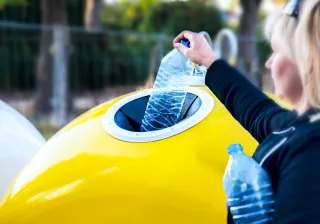The demands on food packaging are growing: the Single-Use Plastics Directive (SUPD) requires natural polymers to be used, and a review of the Packaging and Packaging Waste Directive (PPWD) is coming. The food industry needs new SUPD-compliant alternative solutions with a focus on safety, functionality and sustainability. Multilayer barrier materials can provide the required barrier properties, but their complex structures limit material recycling. Balancing these different goals requires innovations. In legislation, it is essential to set common objectives and define quantitative, but holistic life-cycle analysis (LCA) criteria for preferred solutions.
Food packaging is a complex system: the food packaging business is at the intersection of the food industry, the materials industry and pulp and paper industry. Only joint action between these sectors can sow the seeds for systemic breakthroughs to create sustainable food packages with sufficient reusability, recyclability or biodegradability.
Alternative solutions for barrier materials
VTT and other research institutes have risen to the challenge and are actively searching for SUPD-compliant solutions. Currently, conventional solutions are lacking in either performance (such as cardboard straws) or recyclability (such as mixed plastics). The challenge is to combine several desirable properties, such as recyclability combined with strength, heat-sealability, and oxygen and grease barrier properties. Here are some potential non-plastic barrier solutions compliant to SUPD, gathered and compiled by VTT’s personnel:
- Natural waxes, such as beeswax, carnauba wax and candelilla wax, have been used in hydrophobized papers, but have been mostly replaced by plastics due to performance, availability, affordability and durability reasons. It is time to reconsider waxes, as novel sources of waxes and new technologies can be utilized.
- Natural polymers, like suberin, betulin, lignin and proteins such as hydrophobin overcome some of the limitations, availability and durability, but are not suited to conventional paper converting, and development of e.g. dispersion coating technology is needed.
- Inorganic coatings have excellent barrier properties, but they are fragile and difficult to apply onto paper. For applying advanced ultra-thin layers, novel methods would need to be developed to reach realistic converting speed.
- Metal deposition provides reasonably fast conversion, combined with excellent barrier properties and durability. Unfortunately, metal coatings are not a panacea, as they are problematic in materials recycling.
- Resins and rosins are monomeric, highly hydrophobic natural compounds from conifers. They have some history as sizing, and their derivatives have been developed for hydrophobization.
- Monomeric and dimeric molecules e.g. resin acids, such as derivatized abietic acid, are potential options. Natural molecules are preferred, as synthetics have their own regulatory hazards, as seen from phthalates and nonylphenols.
- Nanocellulose films form uniform films with a good oxygen barrier, but have little to no water vapor barrier properties, and are not stand-alone solutions in many applications.
- Synthetic polymers are also potentially SUPD-compliant if their reusability or recyclability can be demonstrated.
From single issues to comprehensive sustainability
The purpose of a disposable food package is to transport the food safely from the factory to the plate. The package itself has little value: the value comes from the "mobility service" as a part of the logistical supply chain. Well-designed packages already deliver the food item intact, with minimal material losses, carbon footprint and emissions.
Nevertheless, new requirements for performance, sustainability and safety keep on coming from governments, manufacturers, consumers and other stakeholders. The SUPD, aiming to reduce marine plastic litter, is one example. Measures to reduce the negative impacts of food packaging include reuse, recycling, materials design, minimization of non-recyclable materials and the use of sustainable feedstocks. However, the evaluation of sustainability should be based on the entire mobility service, instead of a single issue such as marine litter or choice of material. The European Union needs common goals for defining how sustainability is measured and how these requirements are enforced.
Barrier properties crucial for food package
For food packaging, barrier properties − resistance to diffusion of water, vapor, oxygen, grease, tastes and odours − are key. These should be achieved with a material which is cheap, available, processable, sufficiently strong, and can be shaped into a uniform defect-free layer. The dominant solutions today are thin plastic films, which excel on these metrics.
Some plastics, such as polyethylene, are persistent in the environment and fragment into harmful microplastics. To overcome this problem, legislators devised the SUPD, with a broad ban on plastic materials due to mistrust towards supposedly "biodegradable" plastics. In SUPD, any synthetic polymer is banned, if it forms a separate layer – regardless of its biodegradability or environmental impacts.
The broad ban on synthetic polymers considers only a single negative impact. Insufficient technical performance of other options may lead to a counterproductive increase in the use of packaging materials. For example, in food contact, a plastic layer is legally required with recycled paperboard to prevent food contamination. The polymer layer makes the product officially a plastic product and makes the recycling problem worse, regardless of how little polymer is applied.
Besides this, SUPD contains a mandate for separate collection of plastic if more than 70% of the material can be recycled to virgin quality for reuse. The use of plastic, while allowed, still leads to inevitable losses from the recycling loop and to production of plastic litter. Thus, biodegradability should still be a goal even in recycled packages. The different end goals – reusability, recyclability, biodegradability and performance – are often at odds with each other.
Development of innovative multilayered structures is viable
A single material is unlikely to meet all performance requirements, and combinations of multiple materials into multi-layer products will need to be developed. As written, the SUPD is likely to actually increase the use of packaging materials, if new, non-recyclable barrier layers are needed to accommodate "recycled" or "natural" materials. The danger of promoting harmful pseudo-solutions is real.
Moreover, further regulation is coming, such as the Packaging and Packaging Waste Directive review (PPWD). A comprehensive life-cycle assessment, preferably based on a science-based, standardized scoring system, should form the basis of new regulations. This would allow the regulator and manufacturer to balance between technoeconomic and sustainability considerations. There is no single, simple solution for food packaging, but each application needs to be considered individually.







